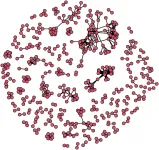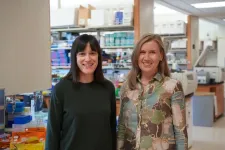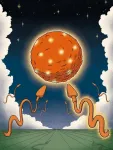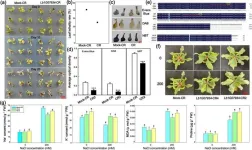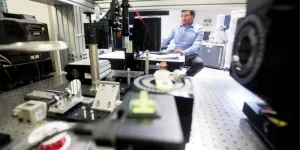(Press-News.org) The formation of relationships within violent US Islamist extremist groups is highly driven by mutual contacts and the tendency for people to bond with others similar to themselves, according to new research. Anina Schwarzenbach, formally of Harvard University and the University of Maryland (currently affiliated with the University of Bern) and Michael Jensen of the University of Maryland present these findings in the open-access journal PLOS ONE on June 5, 2024.
Prior research on social structures within extremist networks have primarily explored outcomes, such as insurgency or conflict, with scant focus on how relationships first arise. The few studies on relationship formation have suggested that, unlike groups that are mostly profit-driven, terrorist groups prioritize trust-based relationships that increase security over those boosting efficiency.
Building on that prior work, Schwarzenbach and Jensen analyzed how trust-based co-offending relationships—relationships between extremists who commit ideologically motivated crimes either together or separately after receiving each other’s influence—form within networks of Islamic extremists radicalized within the United States. They analyzed data from the publicly accessible Social Networks of American Radicals (SoNAR) database, which includes court-record data on relationships between US Islamist offenders.
The researchers first applied algorithms for detecting community structures to SoNAR data, revealing that the US Islamist co-offending network consists mostly of small, separate, close-knit community clusters, with only a few larger communities.
Next, they applied a technique called exponential random graph modeling to SoNAR data to examine the potential roles of homophily—a tendency to bond with similar people—and transitivity—connection through mutual contacts—in the formation of these co-offender relationships. They found that relationships were shaped by mutual contacts, ideological affiliation, spatial proximity, and shared socio-cultural traits, suggesting that both homophily and transitivity help to drive co-offending relationships among US Islamist extremists.
The authors note several limitations to this work, including that their findings may not be generalizable outside of the US or to other kinds of extremist offenders. Still, they say, the findings point to several avenues for disrupting terrorist networks and preventing violence, such the importance of engagement-prevention programs and policing techniques that are informed by the local—as opposed to online— context in which trust-based co-offending relationships typically form.
The authors add: “The results underscore the significance of local connections and personal interaction in the mobilization of extremist activities. They suggest that combating terrorism requires a multifaceted and localized approach, combining efforts in the digital area with traditional police work at a local level.”
#####
In your coverage please use this URL to provide access to the freely available article in PLOS ONE: https://journals.plos.org/plosone/article?id=10.1371/journal.pone.0298273
Citation: Schwarzenbach A, Jensen M (2024) Extremists of a feather flock together? Community structures, transitivity, and patterns of homophily in the US Islamist co-offending network. PLoS ONE 19(6): e0298273. https://doi.org/10.1371/journal.pone.0298273
Author Countries: Switzerland, USA
Funding: This research was supported with a grant (grant number PP400PS 186706) from the Swiss National Science Foundation (https://www.snf.ch/en) awarded to AS. The funders had no role in study design, data collection and analysis, decision to publish, or preparation of the manuscript.
END
US Islamist extremist co-offenders form close-knit groups driven by mutual contacts, homophily effects
Mutual contacts and the “birds of a feather” effect appear to play key roles in forming these close-knit clusters of extremists
2024-06-05
ELSE PRESS RELEASES FROM THIS DATE:
Simple headlines attract more online news readers
2024-06-05
COLUMBUS, Ohio – Online news consumers tend to click on simpler headlines that use more common words and more readable writing, a new study finds.
Researchers evaluated more than 30,000 real-world field experiments from the Washington Post and the online news site Upworthy to see how readers reacted to headlines of varying complexity.
In addition, a follow-up experiment showed that average readers paid more attention to simpler headlines and processed them more deeply – unlike journalists, who paid just as much attention to complex headlines.
The results show ...
Researchers unveil pioneering approach to combat age-related vision loss
2024-06-05
June 5, 2024 (Cambridge, MA) - Cirrus Therapeutics, the University of Bristol, and London’s Global University Institute of Ophthalmology have discovered a revolutionary treatment for age-related macular degeneration (AMD), the leading cause of vision loss among older adults.
Featured on the cover of the journal Science Translational Medicine, this breakthrough research reveals that boosting a specific protein, IRAK-M, in retinal cells could offer a new and highly effective therapy for AMD.
AMD ...
MSU research: What makes a good headline?
2024-06-05
EAST LANSING, Mich. – The competition for online attention in today’s news environment is fierce. High-quality news from credible sources must compete for attention with misinformation and a rapidly increasing amount of partisan content.
How can a news organization stand out as a reputable and trustworthy outlet while driving readers to its site?
The answer is simple: literally.
According to research from Michigan State University, news readers engage more with simple writing, suggesting journalists ...
Scientists identify ‘missing piece’ required for blood stem cell self-renewal
2024-06-05
UCLA scientists have identified a protein that plays a critical role in regulating human blood stem cell self-renewal by helping them sense and interpret signals from their environment.
The study, published in Nature, brings researchers one step closer to developing methods to expand blood stem cells in a lab dish, which could make life-saving transplants of these cells more available and increase the safety of blood stem cell-based treatments, such as gene therapies.
Blood stem cells, also known as hematopoietic stem cells, have the ability to make copies of themselves via a process called ...
Father's diet before conception influences children's health
2024-06-05
Dr. Raffaele Teperino, head of the "Environmental Epigenetics" research group at Helmholtz Munich, along with his research team, has examined the impact of paternal diet on children's health – specifically, the influence of diet before conception. The researchers focused on special small RNA molecules in sperm, known as mitochondrial tRNA fragments (mt-tsRNAs, see background). These RNAs play a key role in the inheritance of health traits by regulating gene expression.
For their study, the researchers used data from the LIFE Child cohort, which includes information from over 3,000 families. The analyses showed ...
Fountain of youth for plants: E3 ligase's role in leaf longevity
2024-06-05
A new study uncovers the intricate molecular mechanisms that regulate leaf senescence in apple plants, focusing on the crucial role of the E3 ligase enzyme, MdPUB23, and its interaction with the ABI5 protein. This research provides valuable insights into how plants manage stress responses and maintain growth, offering potential applications in improving crop yield and stress resistance.
Leaf senescence is a vital phase in the life cycle of plants, impacting overall plant health and yield. Abscisic acid (ABA) ...
Drones and AI harnessed to monitor invasive stink bugs
2024-06-05
Researchers in Italy have unveiled the first successful application of commercial drones combined with artificial intelligence (AI) to monitor the invasive agricultural pest, Halyomorpha halys, commonly known as the brown marmorated stink bug. This research, published in the SCI journal Pest Management Science, marks a significant advancement in the use of unmanned aerial vehicles (UAVs) for automated monitoring of invasive species.
Halyomorpha halys is notorious for its extensive damage to orchard crops across North America and southern Europe. In Italy, this invasive pest caused an ...
Unlocking salt resistance: sea lavender's genetic secret revealed
2024-06-05
Recent research has uncovered the genetic mechanisms behind sea lavender's (Limonium bicolor) salt tolerance by studying basic helix–loop–helix (bHLH) transcription factors. Identifying 187 bHLH genes, the study highlights their roles in salt gland development and stress responses. CRISPR-Cas9 validation demonstrated specific bHLH genes' critical role in enhancing salt tolerance, paving the way for future applications in crop improvement and saline soil management.
Basic helix–loop–helix (bHLH) transcription factors are essential for various plant processes, including ...
Six UTA faculty receive prestigious CAREER grants
2024-06-05
Six faculty members from The University of Texas at Arlington received more than $3.23 million in awards as part of the National Science Foundation’s (NSF) Faculty Early Career Development Program. Called CAREER, these awards are considered the NSF’s most prestigious for early-career faculty and are given to those who have the potential to serve as academic role models in research and education.
Between 2017 and 2022, UTA received nine CAREER awards; in 2023, it received six. Vice President of research and innovation Kate C. Miller called this “a true testament to the world-class research teams we’re assembling here in Arlington.”
“CAREER ...
Brain overgrowth dictates autism severity, new research suggests
2024-06-05
Some children with autism experience profound, lifelong difficulties like developmental delay, social struggles and even the inability to speak. Others experience more mild symptoms that improve with time.
The disparity in outcomes has been a mystery to scientists, until now. A new study, published in Molecular Autism by researchers at University of California San Diego, is the first to shed light on the matter. Among its findings: The biological basis for these two subtypes of autism develops in utero.
Researchers ...
LAST 30 PRESS RELEASES:
New software sheds light on cancer’s hidden genetic networks
UT Health San Antonio awarded $3 million in CPRIT grants to bolster cancer research and prevention efforts in South Texas
Third symposium spotlights global challenge of new contaminants in China’s fight against pollution
From straw to soil harmony: International team reveals how biochar supercharges carbon-smart farming
Myeloma: How AI is redrawing the map of cancer care
Manhattan E. Charurat, Ph.D., MHS invested as the Homer and Martha Gudelsky Distinguished Professor in Medicine at the University of Maryland School of Medicine
Insilico Medicine’s Pharma.AI Q4 Winter Launch Recap: Revolutionizing drug discovery with cutting-edge AI innovations, accelerating the path to pharmaceutical superintelligence
Nanoplastics have diet-dependent impacts on digestive system health
Brain neuron death occurs throughout life and increases with age, a natural human protein drug may halt neuron death in Alzheimer’s disease
SPIE and CLP announce the recipients of the 2025 Advanced Photonics Young Innovator Award
Lessons from the Caldor Fire’s Christmas Valley ‘Miracle’
Ant societies rose by trading individual protection for collective power
Research reveals how ancient viral DNA shapes early embryonic development
A molecular gatekeeper that controls protein synthesis
New ‘cloaking device’ concept to shield sensitive tech from magnetic fields
Researchers show impact of mountain building and climate change on alpine biodiversity
Study models the transition from Neanderthals to modern humans in Europe
University of Phoenix College of Doctoral Studies releases white paper on AI-driven skilling to reduce burnout and restore worker autonomy
AIs fail at the game of visual “telephone”
The levers for a sustainable food system
Potential changes in US homelessness by ending federal support for housing first programs
Vulnerability of large language models to prompt injection when providing medical advice
Researchers develop new system for high-energy-density, long-life, multi-electron transfer bromine-based flow batteries
Ending federal support for housing first programs could increase U.S. homelessness by 5% in one year, new JAMA study finds
New research uncovers molecular ‘safety switch’ shielding cancers from immune attack
Bacteria resisting viral infection can still sink carbon to ocean floor
Younger biological age may increase depression risk in older women during COVID-19
Bharat Innovates 2026 National Basecamp Showcases India’s Most Promising Deep-Tech Ventures
Here’s what determines whether your income level rises or falls
SCIE indexation achievement: Celebrate with Space: Science & Technology
[Press-News.org] US Islamist extremist co-offenders form close-knit groups driven by mutual contacts, homophily effectsMutual contacts and the “birds of a feather” effect appear to play key roles in forming these close-knit clusters of extremists
